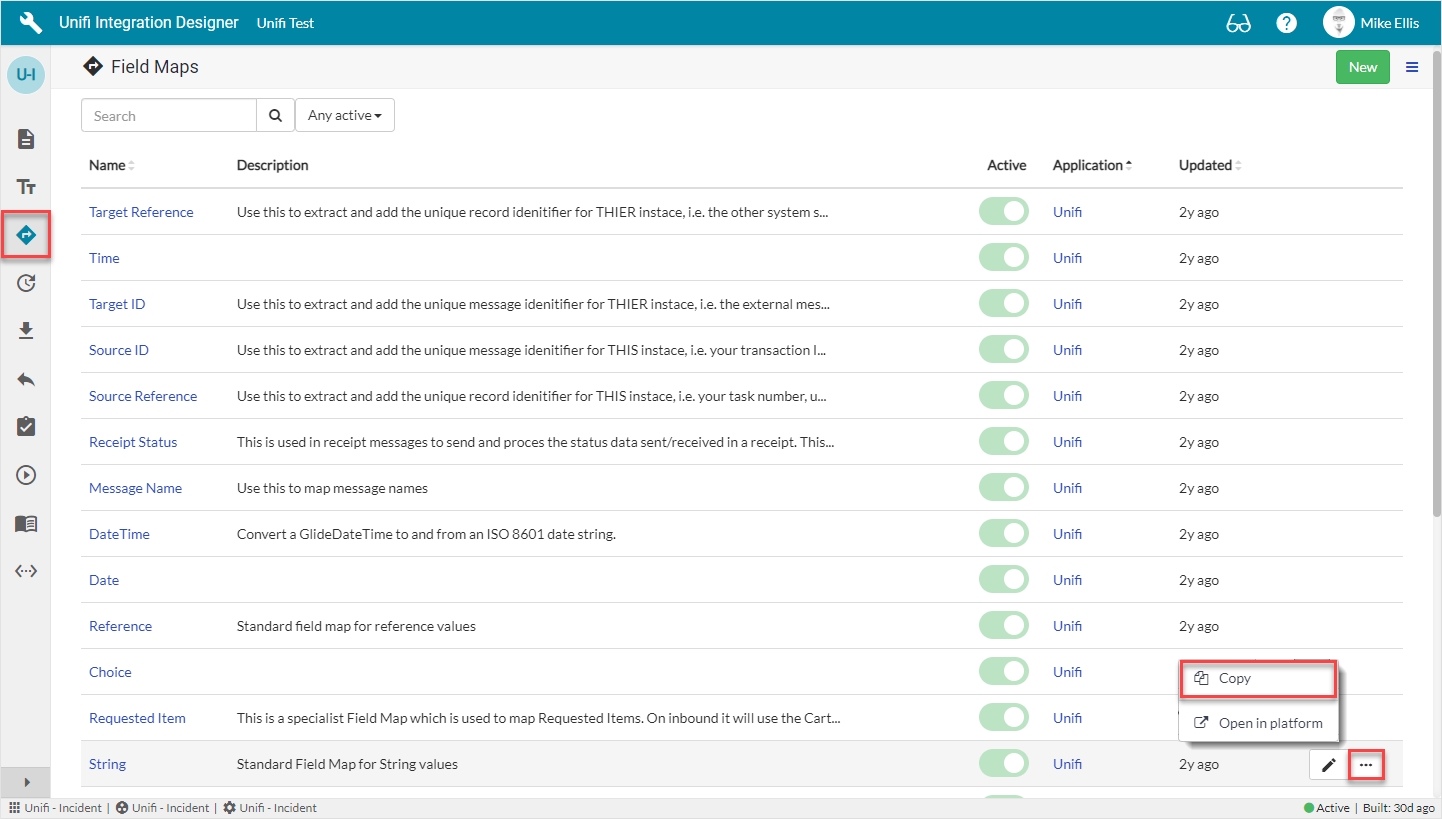Field Maps
Field Maps define template code into which details from Field records are substituted. The resulting blocks of code are wrapped and compiled together into their nominated Message Scripts.
Definition
A Field Map defines the template code used by a Field in the various Message Scripts. It has a template script field for each of the Message Script types (Source to Stage, Stage to Request, Payload to Stage, Stage to Target). The template scripts are compiled during the Build activity where details of a Field record are substituted into the template, producing a Message Script specific to the Message and Field.
The Field Map defines the behaviour, or ‘type’ of a Field. Below is a table of the Field Maps packaged with Unifi:
Boolean
Map true/false values.
Choice
Perform value mapping between internal & external values.
Date
Map date values.
DateTime
Convert a GlideDateTime to and from an ISO 8601 date string.
Journal field
Transform journal fields into objects added to an array to handle multiple journal entry sending.
Message Header*
Compose or consume the message protocol header.
Message Name
Map message names.
Receipt Status
Send and process the status data sent/received in a receipt. This is the transaction process error.
Reference
Map reference values.
Requested Item
Map Requested Items.
Source ID
Extract and add the unique message identifier for THIS instance, i.e. your transaction ID.
Source Reference
Extract and add the unique record identifier for THIS instance, i.e. your task number, user_id etc.
String
Map String values
Target ID
Extract and add the unique message identifier for THEIR instance, i.e. the external message ID.
Target Reference
Extract and add the unique record identifier for THEIR instance, i.e. the other system so their task number, user_id etc.
Time
Map time values.
Unifi - SOAP Control
Scripts to control SOAP messages.
Configuration
If, for example, you wanted to map the Description field as part of the CreateIncident Message, you would only need to configure the incident.description Field (see previous page) and allocate it the String ‘type’ Field Map. There would be no need to configure the Field Map record. This would be the case in the majority of instances, using the shipped Field Maps for standard integrations.
If, however, you had a custom requirement to manipulate or transform data in some unique way, then a custom Field Map can be created.
Best Practice
Best practice is to only use Field Maps that belong to an Integration. You can do this by copying the OOTB Field Maps which are shipped with Unifi and labelling them as belonging to a particular Integration. This should be done for each Integration. That way any future updates which may be made to any of the OOTB Field Maps will not impact any of your Integrations and each Integration will comprise its own stack of self-contained records.
Example
In this example we will copy the OOTB String Field and rename it to be used for the Incident Guide Integration.
To copy the String Field Map, navigate to the Field Maps page.

Click on the ellipsis to the right of the String Field Map & then click Copy.
On the Copy Field Map modal, update the Name and Integration as appropriate & click Copy.

*Name: We have chosen to prefix the existing Field Map Name with the initials of our Integration (you are free to choose any appropriate means of identifying/differentiating).
Code in Action
The following is an example of a Source to Stage Message Script template from the String Field Map. The code between the dollar braces, e.g. $[field.element], is executed as JavaScript during the compile phase. The field variable is the Field GlideRecord object.
The following block of code is extracted from The Source to Stage Message Script belonging to a CreateIncident Message which was generated using the above String Field Map template against the incident.description Field:
Integration Phases
To help you understand and give some context as to where these configuration records fit, we thought it would be helpful to layout the phases of an Integration as we see them.
Configuration Phase
Field records are configured and linked to Messages (and/or Integrations) and Field Maps.
Field Maps can be edited or created as needed.
Field Choice records are added/edited as needed.
Build Phase
The configurations defined by Fields and Field Maps are compiled into executable code and stored in Message Scripts. Existing Message Scripts simply have their code updated. Code outside of the demarkation comments in the Message Scripts is retained.
Operational Phase
Messages and Message Scripts (and Field Choices) are interpreted and executed.
Operational records such as Bonds, Stages, Transactions and Requests are generated and maintained.
Was this helpful?
